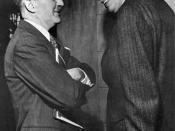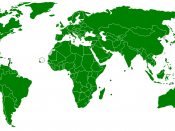After the First World War many countries were left in unstable conditions. Infrastructures were in flux, economies were in isolation, and exchange rates were volatile especially in the 1930's. Alongside these prevailing conditions, an increasing number of governments enforced restrictive trade policies. As a result, the United States in conjunction with Great Britain in the 1940's created proposals for the design of a new financial institution that would control exchange rates and strengthen international trade. It was also hoped that such action would aid in the recovery of the Europe and curb the effects of the WW1 (Carbaugh, 2002).
During the year 1944, representatives of 45 countries gathered at the United Nations Monetary and Financial Conference in Bretton Woods, New Hampshire. Throughout this meeting, they discussed a variety of financial issues including exchange rates and protectionist trade, along with the European recovery from the war.
The culmination of this meeting resulted in the Bretton Woods Agreement. Its function was to create an international monetary system of convertible currencies, fixed exchange rates along with free trade. As a catalyst to these functions, the agreement created two international institutions: the International Monetary Fund (IMF) and the International Bank for Reconstruction and Development (the World Bank). The goal was to provide economic aid for reconstruction of postwar Europe (Hawtrey, 1946).
While the International Trade Organization that was proposed in the Bretton Woods Agreement was not endorsed by the United States, it was later backed in 1947 but in the form of the General Agreement on Tariffs and Trade (GATT). This new agreement was also ratified by 23 other countries, and would grow to become the World Trade Organization that we are familiar with today. In recent decades the World Bank and IMF have been responsible in aiding numerous countries regain stable economies.


